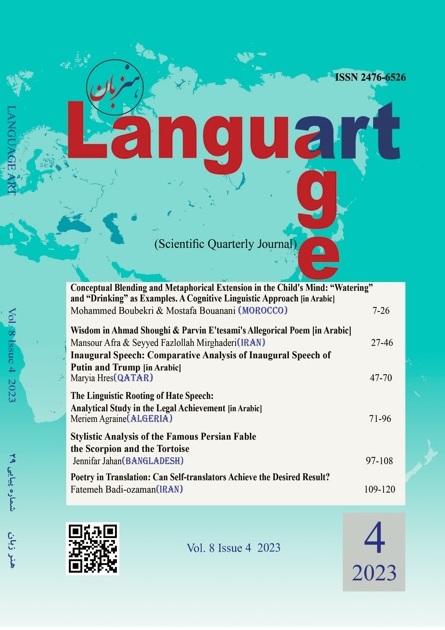Poetry in Translation: Can Self-translators Achieve the Desired Result?
DOI:
https://doi.org/10.22046/LA.2023.24Keywords:
Self-Translation, Translated Texts, Poetry, BilingualismAbstract
There is no shortage of translated texts; nonetheless, self-translations are quite scarce. Ignoring definitions from other disciplines, in the field of Translation Studies, self-translation refers to original works translated by the author themself, leading to the author and translator being the same person. Given the rarity of self-translations, research on such texts is understandably even rarer. To fill in this gap, a self-translated poetry book was selected as a case study in this article. On one hand, self-translations can be analyzed like any other translated text; accordingly, the selected poems were examined using Lefevere's approaches to translating poetry. On the other hand, Grutman’s framework regarding the self-translator’s bilingualism and the power dynamics between the two languages was also applied. It was concluded that, since this self-translator was also the poet and held intellectual property rights to the material, he had the deepest understanding of his content. Consequently, any changes he made during the translation process were justified.
References
Dastjerdi, H. V., Hakimshafaaii, H., & Jannesaari, Z. (2008). Translation of poetry: Towards a practical model for translation analysis and assessment of poetic discourse. Journal of Language and Translation, 9(1), 7–40.
Ferdowsi, S., & Sharififar, M. (2014). The theory and practice of poetry translation. Jahad Daneshgahi Kerman branch.
Free verse. (n.d.). In Literary Devices. Retrieved October 26, 2023, from https://literarydevices.net/free-verse/
Grutman, R. (2013a). Beckett and Beyond: Putting Self‐Translation in Perspective. Orbis Litterarum, 68(3), 188–206. https://doi.org/10.1111/oli.12016
Grutman, R. (2013b). A sociological glance at self-translation and self-translators. In A. Cordingley (Ed.), Self-translation: Brokering originality in hybrid culture (pp. 63–80). Bloomsbury.
Grutman, R., & Van Bolderen, T. (2014). Self-translation. In M. Baker & G. Saldanha (Eds.), Routledge encyclopedia of translation studies (2nd ed., pp. 257–260). Routledge.
Hokenson, J. W., & Munson, M. (2007). The bilingual text: History and theory of literary self-translation. Routledge.
Lunenburg, F. C., & Irby, B. J. (2008). Writing a successful thesis or dissertation: Tips and strategies for students in the social and behavioral sciences. Corwin Press.
Oliver, M. (1994). A poetry handbook. Harcourt Brace & Company.
Perry, M. (1981). Thematic and structural shifts in autotranslations by bilingual Hebrew-Yiddish writers: The case of Mendele Mokher Sforim. Poetics Today, 2(4), 181–192. https://doi.org/10.2307/1772195
Popovič, A. (1975). Dictionary for the analysis of literary translation. Department of Comparative Literature, University of Alberta.
Rhyme scheme. (n.d.). In Literary Devices. Retrieved October 26, 2023, from https://literarydevices.net/rhyme-scheme/
Shariati, M. (2010). My puce rose. Islamic Azad University of Jiroft.
Wanner, A. (2018). The poetics of displacement: Self-translation among contemporary Russian-American poets. Translation Studies, 11(2), 122–138. https://doi.org/10.1080/14781700.2017.1317655
Downloads
Published
How to Cite
Issue
Section
License
Copyright (c) 2023 Fatemeh Badi-ozaman

This work is licensed under a Creative Commons Attribution 4.0 International License.

